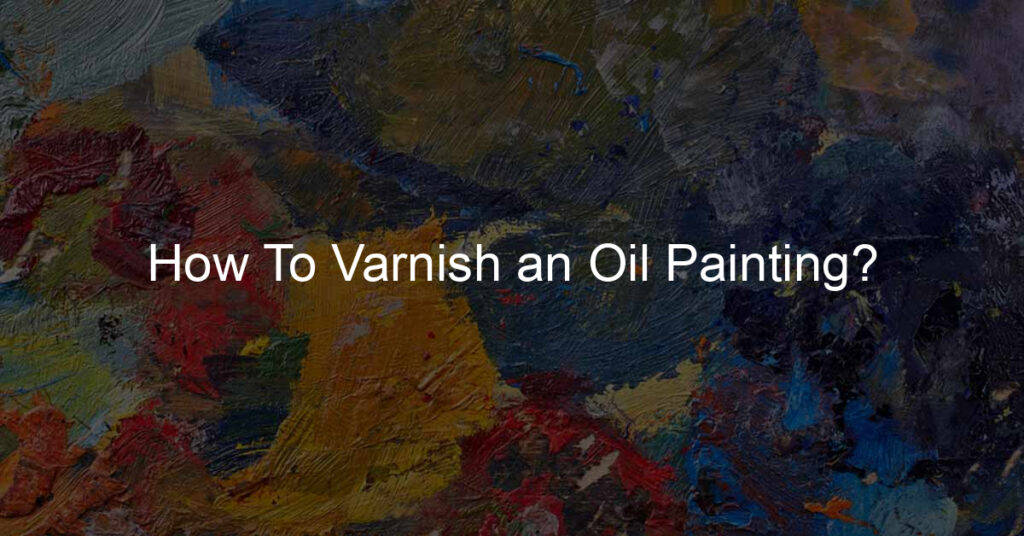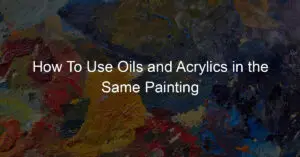Once you have prepped your painting for varnishing, you are ready to apply the varnish.
Select an appropriate varnish for your painting. Depending on the type of oil paint used and the desired finish, there are a few different types of varnishes available.
For example, glossy or matte finishes can be achieved by using a high-gloss resin or a soft matt varnish, respectively.
Mix the varnish thoroughly before use and ensure that it is free from any dust particles which could damage the painting’s surface.
Gently clean off any dust that may be on your brush with a lint-free cloth before use.
Dip your brush into the prepared varnish and start to paint the varnish onto the painting in long, even strokes. For best results, work from top to bottom in a single direction.
A glossy finish can be achieved by applying several thin layers of varnish and allowing each layer to dry before adding another.
Take care not to over-varnish as this may cause yellowing or cracking. If you are after a matte finish, one thicker coat is usually sufficient.
Once you have finished applying your varnish, leave it overnight to dry completely before putting it on display or storing it away for later use.
With proper care and regular cleaning, your painting should remain well-protected for years to come!
Do You Need To Varnish an Oil Painting?
Yes, it is important to varnish an oil painting to protect the surface and colors from dirt, dust, and moisture.
Varnish also provides a protective layer that prevents pigment from fading over time due to exposure to light.
Additionally, varnishing can bring out the vibrancy of colors, create a beautiful shine, and prevent oxidation which can cause yellowing.
There are several types of varnishes available on the market so be sure to select one that is appropriate for your painting’s needs.
For example, some may provide a glossy finish while others may give a softer matte finish. Applying varnish correctly will extend the life of your painting and keep it looking beautiful for many years to come.
It is important to note that varnish should only be applied to a finished painting, as the solvents in the varnish can cause the paint to re-wet and smear during the drying process.
Additionally, some types of varnishes may not be compatible with certain oil paints so it’s best to check with your local art supplies store for advice on which one will work best for you.
How Long Should I Wait To Varnish an Oil Painting?
When you varnish a painting, you need to wait until it dries. This can take a few hours or even a few days, depending on the painting’s size and the thickness of the varnish.
The key with this is to not dry brush (or press) your painting while it’s still wet. For most paintings, you should allow at least four hours for drying time before you varnish them.
In addition, you must make sure that the paint has dried completely before you put any other coats on top of it.
You also need to allow some time for the paint to get tacky again so that you can apply the varnish effectively when applying the second coat.
You should expect about an hour of drying time after applying your first coat.
How Long Does Varnish Last on Oil Painting?
When you varnish an oil painting, the finished product will last for years. The varnish is a sealant that protects the painting from stains and grime.
Over time, however, dirt will build up on the varnish and it won’t protect your painting from tarnishing. That’s why you need to reapply varnish every few years.
How Do You Apply Varnish to a Painting?
Applying varnish to a painting is quite an easy process.
First, you will need to make sure that the painting has been allowed to dry completely and that any dust or debris has been removed. Once this is done, you can begin applying the varnish.
Start by pouring some of the varnishes into a shallow container and preparing it according to the manufacturer’s instructions.
Wipe off your brush thoroughly before use and ensure that it is free from any dust particles which could damage the painting’s surface.
Gently clean off any dust that may be on your brush with a lint-free cloth before use.
Dip your brush into the prepared varnish and draw it in a single direction across the painting’s surface.
A thin, even layer is all you need – making sure to cover every part of the painting but avoiding any puddles or excess.
Remove any excess with a clean cloth and leave the varnish to dry for several hours before applying a second coat if needed.
By following these steps, you can easily apply varnish to an oil painting and make sure that your artwork stays looking vibrant and beautiful for years to come.
With the right care, your painting should remain well protected against dirt, dust, and moisture so that you can enjoy it for many years!
What Is the Best Varnish To Use on an Oil Painting?
The best varnish to use on an oil painting is a glossy finish that will give the painting a professional look and extend its life.
We recommend using an alkyd resin varnish for this purpose as it is durable, fast-drying, and resistant to yellowing over time.
Other types of varnishes such as acrylic or polyurethane, can also be used but may not provide the same level of protection.
Be sure to check with your local art supply store before purchasing any materials so you can select the right option for your needs.
Varnishing an oil painting requires time and patience, but it’s well worth it to protect and preserve your artwork.
Good Luck.


















